As a retro gamer, I had the pleasure of growing up in an era where real-time strategy games began to take a foothold. “Warcraft” and “StarCraft” were particular favorites of mine, mainly because I enjoyed the resource management aspect and marching armies across the map to reign unholy terror on my opponents. “Hexica”, while not a video game, takes what I like about the aforementioned games and adds a capture the flag element. Players will not only be managing money and a fleet, but will be racing to capture flags as they appear. Before we take a look at this game in further detail, I’d like to thank Eli Ortiz for reaching out to me and providing me with a copy of the game.
Editor’s Note: It’s important to mention that the game is still in development and will soon hit Kickstarter to help mass produce it (as of 4/11/13). The copy I received is therefore a handmade prototype. The components in the factory copies (that will be sold to the public if the Kickstarter campaign is successful) will be of slightly better quality, though I had enough to work with to do a full review.
Components
Game Board – The game board is mostly made up of hexes that serve as the main playing area. Around the perimeter of the board are score trackers for each player and includes a flag pool for flags not yet placed on the board.
Ships – There are four sets of ships, one of each color. A set includes a mothership, harvesters, salvagers, and various attack ships. Each ship type has a set of attributes, along with an associated cost. Motherships are powerful beasts, but must be protected lest the player be eliminated from the game. Harvesters collect credits for the player while salvagers carry flags and loot space debris (from destroyed ships) for credits. The F13s and F35s are attack ships of varying strengths whereas the bandit can capture an enemy ship and make it their own.
Damage Cubes – These cubes come in various colors, each color having a different point value. These cubes allow players to track how bad a particular ship is damaged as a result of combat.
Flag Cubes – White cubes represent flags that will be spawning on the playing area during the game. Players will be attempting to capture a set number of flags in order to win the game.
Advanced Systems Cards – These cards act as special modifiers that give players special abilities during the game. They come in green (economical), yellow (movement), red (attack), and blue (defense).
Credits – Players will be earning credits to spend on ships (buying new or repairing damaged ships) and advanced systems cards.
Dice – There are two six-sided dice (red and blue) and two twelve-sided dice (purple and yellow). The six-sided dice are used during combat whereas the twelve-sided dice are used to randomly spawn flags on the game board, when appropriate.
Reference Cards – Players receive a reference card to help them keep track of turn order and ship attributes.
Setup & Gameplay
At the start of the game, players choose a color set of ships and place a mothership, four harvesters, and one salvager on their “Start” space. Each player also receives two random advanced systems cards and a reference card. White cubes are placed on the spaces reserved for the flag pool on the side of the board, the number of which will change depending on how many people are playing the game. The player who rolls the highest D12 value goes first.
On a player’s turn, they’ll observe six phases:
1) Roll to Spawn Flag – The current player will roll a yellow and purple die to spawn a flag at the coordinates indicated.
2) Roll for Credit Bonus – The current player will roll a blue die to determine how many credits they’d receive as a one time bonus.
3) Collect Harvester Credits – The current player will receive one credit for every harvester they have. If a harvester happens to be on a space containing a gas cloud, that harvester earns the player two credits instead of one.
4) Spend Credits – The current player can use credits to buy ships, repair ships, or buy advanced systems cards.
5) Move Ships – The current player can move any of their ships. The maximum number of spaces a ship can move is determined by its movement cost.
6) Attack – The current player can attack with any of their ships capable of doing so by rolling the red die. Each ship can only attack once per turn and must observe the range attribute to determine if they are close enough to attack an enemy ship. Ships that can attack have a low attack value and a high attack value. An attacking player who rolls a one, two, or three hits with a low attack and an attacking player who rolls a four, five, or six hits with a high attack. The defending player then rolls a blue die to see if the attacker misses. Rolling a one on the blue die counts as a successful dodge for the defender. Damage cubes are assigned appropriately, depending on the outcome of the battle(s).
Players will be taking turns, attempting to capture flags with their salvagers as they appear and bring them back to their mothership. The player who manages to capture a set number of flags first wins the game. Alternately, a player can destroy all of the enemy motherships on the board. A player who destroys an enemy mothership gains everything the other player had, including any flags that they may have captured.
The above doesn’t cover all of the rules found in the manual, but should still give you an idea of how the game is played. For more information, you can view a helpful tutorial video, here:
http://www.youtube.com/watch?feature=player_embedded&v=6CZY-5xHwTs
The Review
As I indicated above, the prototype copy I received is handmade and will be slightly different than the final version (post factory). The game pieces in the factory version will be thicker and made of cardboard, for example. The money tray in the final version will be of better quality plastic than the one featured in my copy. Regardless, I was still pleased by the quality of the components as they functioned well during our play sessions. Vinnie’s (12) eyes lit up like they usually do when confronted with new spaceships to play with, even if they are two-dimensional. The rules were easy to understand and the kids had no trouble picking up the concepts behind the game. I do appreciate the clear and concise manner of the tutorial video, which is linked above for your reference. The video made explaining the game to others a bit easier.
As an avid fan of real-time / turn-based strategy games, I was immediately attracted to the idea behind the game. In a normal game of “Warcraft” or “Starcraft”, for example, players build workers to gather the resources they need to build up their base and forces. I found it cool that I was able to apply some of the strategies I used in said games with this one. For example, one player might choose to forgo building a lot of harvesters from the get go and focus on attack ships to attempt a “Zerg rush” of sorts. Others might simply build harvesters en masse to ensure that they can dominate the battlefield later down the line. Since up to four people can play, you could divide players up into teams or just have at it in a free-for-all match, much like you can in typical RTS (real-time strategy) video games.
With that said, some strategy games are harder and more complicated than others. Video games like “Rise of Nations” and “Supreme Commander” are a bit harder to play than say, “Warcraft II”. “Hexica”, in my opinion, is on the simpler side but not overly so to where players won’t have anything to think about. For example, there are only two ships that attack (not counting the mothership), but players will still need to consider their respective costs and attributes. Bandits won’t be able to directly damage enemy ships, but have a one in three chance of converting enemy ships to their side. The mothership has a ton of health and can wallop on anything from a good distance, but losing it is an instant-loss for the player. While there may not seem like a lot of ship types available, you’ll have your hands full managing the ones you’ve been given.
The advanced systems cards mix things up well, much like the alien tech cards do in “Alien Frontiers”. They add a mystery element to the game as you never know what your opponent may throw your way at any point during the game. These cards have caused me to play conservatively, for fear of being caught off guard and in the open. Being able to purchase these at will open up some more gameplay strategies for one to consider. You could, in theory, purchase a lot of these cards and neglect your fleet (for the most part) in order to pull off surprisingly powerful sneak attacks in the hopes of winning the game. You could ignore these cards altogether and just play with the two you started with.
It’s possible to mod “Hexica” to suit your group’s needs or to change things up, though it may take a play session or two to see if the changes you make break the balance of the game. For a quicker game, you could implement a rule that prevents motherships from repairing, for example. You could also take advanced systems cards completely out of the game. Creative folks will come up with their own ideas and it’s nice to see that the game can be changed so easily…though the core rules are fine as-is for the most part. The only real issue I had with the game was how random the flag spawns were. A particular player could lose the game no matter how well they played, if flags spawned close to the enemy mothership on a regular basis. The size of the board and the rules of probability make this unlikely, but it’s still possible nonetheless. If I were to mod the game in any way, it would be to introduce some sort of re-roll system during phase one that would kick in after so many flags spawned near a player’s mothership. Better yet, each player could be given the power to force a re-roll one time during phase one of the game, no matter whose turn it is. It should be noted that one of the advanced systems cards do allow a re-roll. I’ll have to experiment further to see if any of these ideas are plausible.
The game is simple enough for kids to learn, yet deep enough for adults to seek their teeth into. It’s like “Othello” and “Chess” in the sense that the game is simple to learn, but may take a while to fully master. That was evident when Vinnie made his moves during the game as he didn’t often think ahead to consider what would happen five or ten moves down the line. Regardless, he played with ruthless vigor and had no trouble learning the rules of the game. I have no doubt that given enough time, he will start thinking long-term and give me a run for my money. While there is a bit of luck involved, there isn’t enough to overshadow the strategy element by any means. Players may have a run of bad luck in one game with credit bonuses, battles, and flag spawns, but that could easily change in the next game. The luck factor does help to contribute to the game’s replayability, since two games are extremely unlikely to ever be the same.
During our play session, everyone started out strong and went for those gas clouds in order to cash in on those credits on the next turn. I had the good fortune of being drawn two economic cards, one allowing me to place four harvesters anywhere I wanted and another that doubled my harvester income for a turn. I was thus able to get the jump on the other two and build up a sizable fleet, saving the rest of my money for emergency mothership attacks (which costs five credits). Fearing retribution from me, the kids turned on each other while I collected flags. I managed to grab four, but some lucky rolls placed the rest near both of their motherships, forcing me to go after one of them in an attempt to eliminate them for their flags. Anthony (17) had done some damage to Vinnie’s mothership, but I used a purchased advanced systems card to move three of Anthony’s ships away from the area, allowing me to swoop in and get the kill. It was a tense game, though there was definitely room for being ganged up on. Parents may want to mediate if more than two competitive kids are playing at the same time and stress the importance of being a graceful winner/loser.
In the grand scheme of things, “Hexica” is a fantastic turn-based strategy game that left me wanting more. Out of all of the board games I’ve played so far this year, “Hexica” is probably my favorite. I don’t like using the term “must-buy” because everyone has different tastes in gaming, but I can compel fans of the genre to seriously consider picking this up and/or supporting the Kickstarter campaign. The game is listed for forty bucks on the official website below, which isn’t a bad price all things considered. Handmade copies like mine were available for a limited time on the site’s store page, but the stock appears to be sold out at the present time (as of 4/11/13). Interested parties will need to wait until after the Kickstarter campaign is complete to see if any more will be made, assuming that no more handmade copies are in the works. Even if you’re not a fan of turn-based strategy games, it’s worth a look, mainly due to how simple it is to learn and play. If anything, your kids or grandkids may get a kick out of playing it.
Final Verdict: 10/10
—
You can learn more about “Hexica” by visiting the following websites:
http://boardgamegeek.com/boardgame/137362/hexica
You can support the game by contributing to its Kickstarter campaign, here:

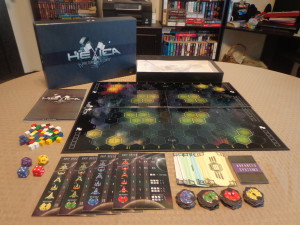
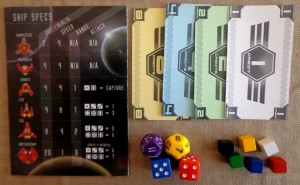
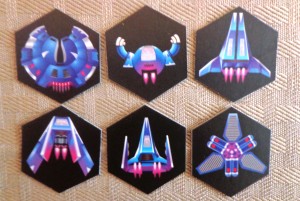
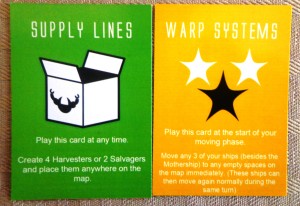
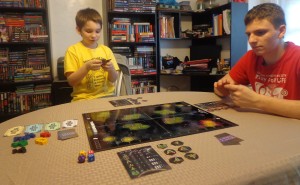
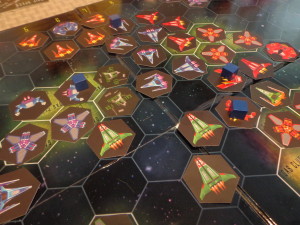
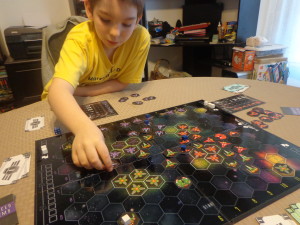
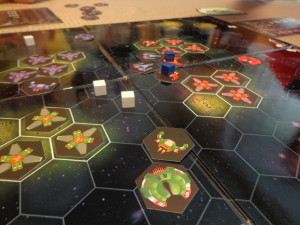
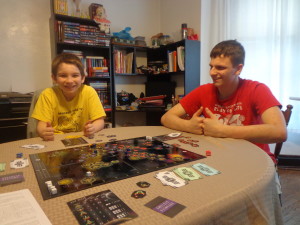
Thanks so much for the speedy review! Great writeup!
My pleasure! Thanks for sending the game.
Got some good news! Just launched the Kickstarter for Hexica. Here’s the link:
http://www.kickstarter.com/projects/gameyy/hexica?ref=live
Thanks Eli! I updated both this review and the one I posted on BGG. Thanks!
BTW, if you and Eric feel that adding the link to this review on your KS page would help folks out, please do. Thanks!